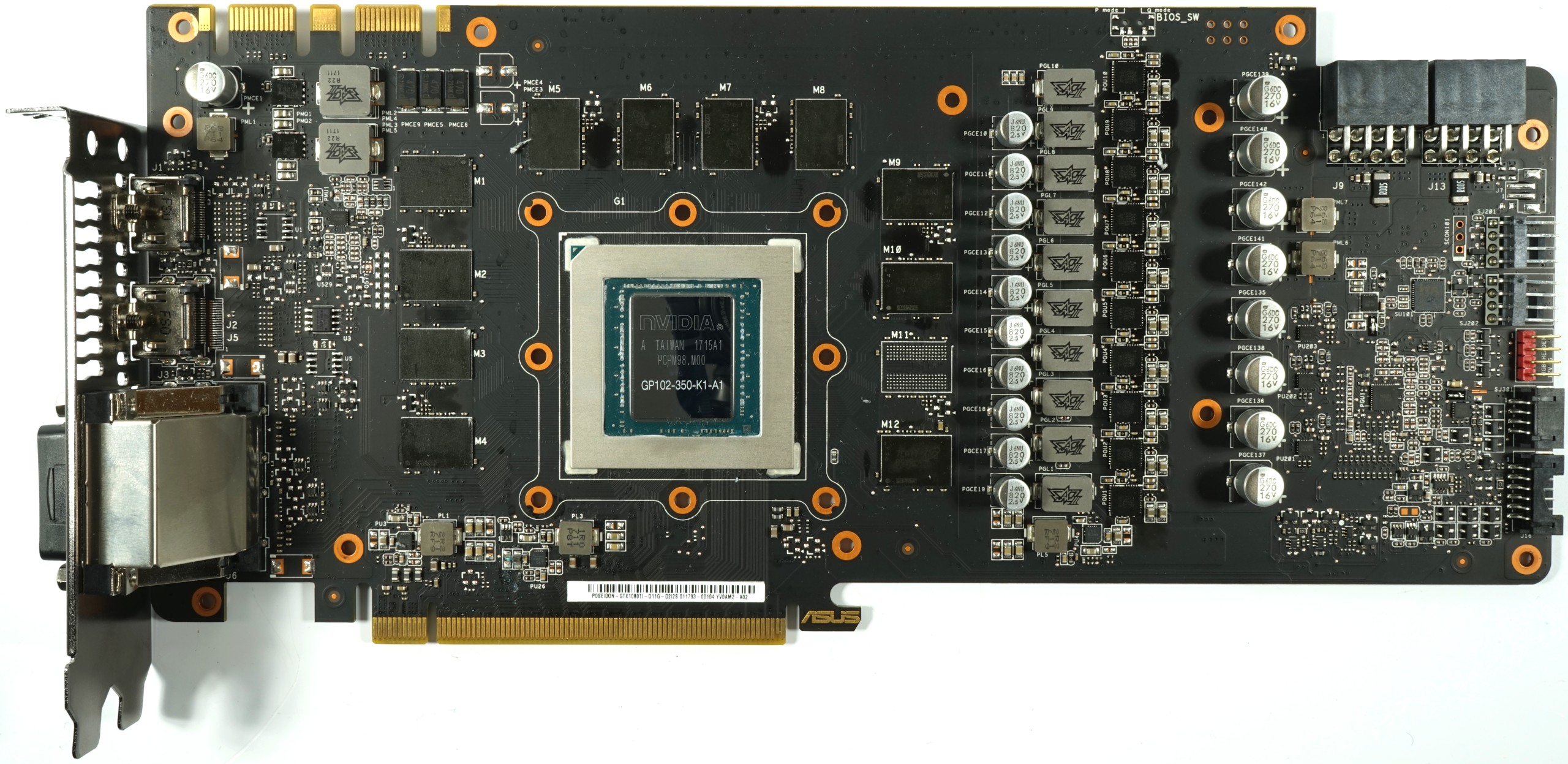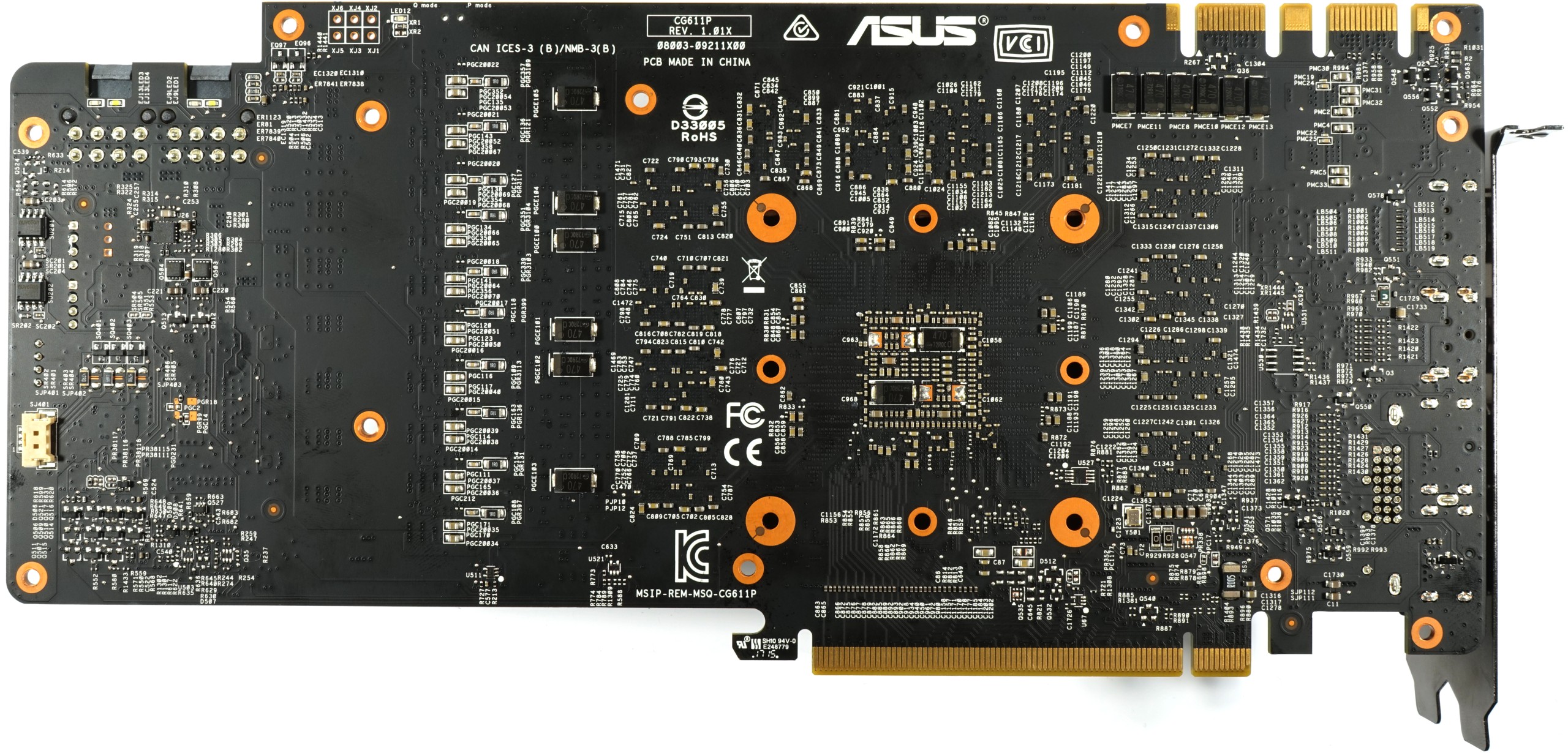Asus ROG Poseidon GeForce GTX 1080 Ti 11GB Platinum Edition Review
Why you can trust Tom's Hardware
Board & Power Supply
Asus uses its own design for this board. Behind a pair of eight-pin auxiliary power connectors, the board has two chokes to smooth out spikes in the electrical input.
The ROG Poseidon GeForce GTX 1080 Ti 11GB Platinum Edition employs a 5+2-phase power supply with doubling. Thus, each phase is able to distribute the load between two parallel control circuits. You can see the memory's two phases on the card's top-left.
Asus keeps the back of its card tidy-looking. It's home to the memory's PWM controller and a number of other components.
| GPU Power Supply | ||
|---|---|---|
| PWM Controller | uP9511 uPI SemiconductorEight-phase buck controllerFive phases in use (doubled) |
VRMIR3555 International Rectifier 60A PowIRstage Includes high- and low-side MOSFETsIncludes Schottky diode
CoilsSAP II Super Alloy Power Ferrite core coils
Memory & Memory Power SupplyModulesMT58K256M321JA-110 Micron 11 x 1GB GDDRX5 11 Gb/s 1375 MHz
PWM ControlleruP9013 uPI SemiconductorTwo phases
Get Tom's Hardware's best news and in-depth reviews, straight to your inbox.
VRMFDPC5018SG Fairchild30V Asymmetric Dual N-ChannelIncludes high- and low-side MOSFETsIncludes Schottky diode
SAP II Super Alloy Power Ferrite core coils 220 nH
Other ComponentsMonitoringINA3221 Texas InstrumentsHigh-side current and bus voltagemonitor
Fan Control8915FN ITE Fan controlMonitoring
BIOSWinbond 25Q40 Kynix Semiconductor EEPROM Single BIOS
MiscellaneousOther Highlights(2) Eight-pin auxiliary power connectorsFilter coils for power input Controlled fan connector for case fansRGB connector for custom GGB stripesVoltages and other sensor output
MORE: Best Graphics Cards
MORE: Desktop GPU Performance Hierarchy Table
MORE: All Graphics Content

Igor Wallossek wrote a wide variety of hardware articles for Tom's Hardware, with a strong focus on technical analysis and in-depth reviews. His contributions have spanned a broad spectrum of PC components, including GPUs, CPUs, workstations, and PC builds. His insightful articles provide readers with detailed knowledge to make informed decisions in the ever-evolving tech landscape
-
Pat Flynn I wonder how their cooler compares to something like EKWB's blocks? Temps/overclock wise that is.Reply -
dan88rx7turbo I have the Poseidon , sits at about 43c on load in Valley and Superposition 4k , 1080p extreme settings!Reply -
JackNaylorPE 1. The Poseidon is a great idea in concept but suffers from poor implementation.Reply
2. The addition of the PCB parts is a welcome addition. However w/o an explanation of how they differ from reference cards or compare to other AIB cards, it inda falls flat.
3. Benchmark Comparisons w/ just the reference model again leaves me wanting more. Asus Strix would at least allow comparisons to other AIB cards
.
4. And yes .... would have been very useful to compare against other options. An EVGA Hybrid and say the MSI Seahawk EK X (w/ full cover EK water block) would also be a big plus.
-
drmacaron i also have a poseidon. Super good temp dont know why the warer development aded maby if you should clocke it bigtime ?Reply -
mac_angel I have the Asus Strix 1080ti OC. It 'boosts' to 2Ghz on it's own. But playing with the curve in Afterburner, I get 2076MHz, on air. That's without flashing the ROMReply -
JackNaylorPE Reply20192947 said:I have the Asus Strix 1080ti OC. It 'boosts' to 2Ghz on it's own. But playing with the curve in Afterburner, I get 2076MHz, on air. That's without flashing the ROM
The OC is be expected ... from the article :
With sufficient water cooling, however, we were able to reach 2076 MHz. That's where our chip hit its ceiling, even after installing a high-end loop, increasing the power target, and applying a bit of extra voltage.
But outta the box, the boost is down at 1708 / 1709
http://www.tomshardware.com/reviews/asus-rog-poseidon-gtx-1080-ti-platinum,5151.html
-
Rheotome Both of these statements are incorrect:Reply
"lay down a flat heat pipe on a large sink and, as an option, send water through to dissipate thermal energy"
"The thermal solution utilizes a copper sink that doubles as a block for water cooling (by guiding liquid through the hollow heat pipe). "
No water flows through a heat pipe. A heat pipe is hollow, closed and sealed to contain the working fluid that evaporates and condenses to transfer heat from a hot to cold point.
The author is confusing heat exchanger and heat pipe technology. -
JackNaylorPE Actually, no ... there is no air involved in a heat exhangerReply
"A heat exchanger is a device used to transfer heat between a solid object and a fluid, or between two or more fluids."
The proper term here would simply "radiator tube" under normal circumstances ... as it is employed here, it's simply part of a hybrid water block, heat sink / radiator.

